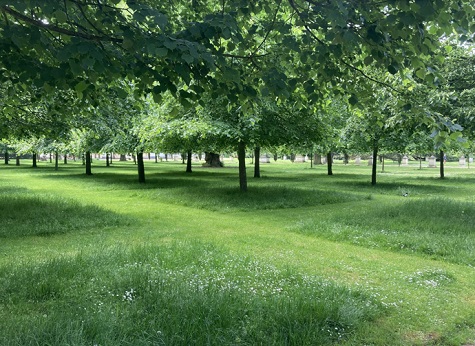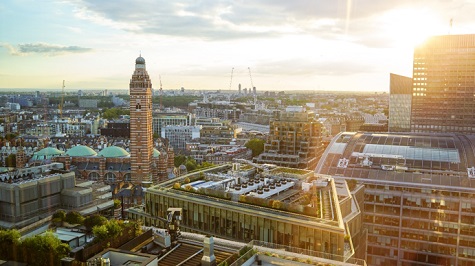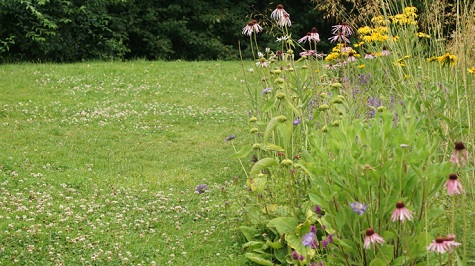
PICTURED ABOVE: Chiswick House & Gardens

In this series of articles, I am taking the opportunity each month to look in more depth at individual organisations. How are they seeking to be more sustainable and, importantly, how are they seeking to advise and support members or customers?
This month we focus on Parks For London and their work across the capital city interacting with and supporting those managing green spaces.
Parks For London is a charity supported by funding partners. The charity does not deliver, own or manage green spaces, rather it supports those who do, and a key aim of the work is helping them achieve more sustainable practice. Parks For London has four directly employed staff. Tony Leach has headed up the team until recently. I had an extremely interesting discussion with Tony in compiling this article. The charity was originally based in City Hall but now all staff work from home.
Vision, Mission & Role
Parks for London’s raison d’etre is advancing green space excellence and it has grown to be the leading strategic voice and champion for London’s green space sector. They work with, and support, landowners and managers of London’s green infrastructure to share and develop good practice, improve standards and maximise resources. In doing this, they work to statements of vision, mission and role summarised as follows.
In delivering on this and achieving change, Parks for London seeks an impact focussed approach using its influence, and providing positive and pro-active encouragement to partners. They organise topical events and meetings to bring together the people who own, plan, design and manage London’s parks and green spaces to address issues, share experience and engage with statutory bodies and councillors. They work collaboratively with universities, the private sector and local authorities to support new research, technologies and projects, and they provide strategic advice to policymakers and land managers, and offer consultations to support London Boroughs to help identify areas of improvement based upon their performance against their ten good parks criteria.
Good Parks Criteria
The latter is an established benchmarking process across the 33 London boroughs and they seek information from each of these bi-annually. There is much data collected which is extremely informative. Publishing the results is not judgemental but seeks to encourage improvements by peer review. Good Parks for London reports upon, promotes and celebrates the work that London boroughs and other land managers do to maintain and develop London’s parks and green spaces. The aim of the reports is to promote good sustainable practice, raise quality standards and help lobby to protect park budgets and resources. The reports assesses how London borough parks services perform against the ten Good Parks criteria and showcases examples of good practice and case studies.

Ed Stannard was Development Officer Parks for London and now heads up the team of staff. The following is extracted from discussion with him.
Much is said about the creation of high-quality and publicly accessible green and open spaces in London and the multiple benefits these bring to communities, wildlife, and the environment. To this end, significant capital investment is made each year to create such spaces—a trend which shows no sign of abating. But what thought, and resource is given to the long-term management and maintenance of these spaces? What can be done to embed these places into the communities they serve, and ensure they change and adapt to constantly changing needs, challenges, and the environment? With each passing year Ed sees and hears of organisations in their network putting increasing emphasis on placekeeping and making the case for revenue funding, development, and engagement—actively contributing to sustainable and vibrant communities, better realising the long-term impacts of capital projects, and building positive and meaningful relationships with those that live, work, and play near their spaces.
In their work, Parks for London share a selection of case studies showcasing good place-keeping across London and aim to help landowners and managers create a sense of belonging, attachment, enjoyment, and pride for both users and visitors. Those responsible for such spaces need to engage and integrate the needs of multiple user groups into long-term planning and development. At Parks for London, they help managers of green spaces to reflect on the wider benefits that green spaces offer and identify further opportunities for them and the communities they serve.
Sustainable Practice
A key category in the benchmarking is sustainability with ten specific criteria, including measuring the extent of use of ‘green’ equipment, route planning, recycling, use of integrated weed management plans, specific actions taken to reduce carbon foot print etc. The overriding objective is to push forward best practice and the results over time are improving across all areas. Once the data is collected and analysed, one to one follow up meetings take place, before publication on the web site and normally an event to announce outcomes. The last report was in 2023 and a further one is planned for 2025. Parks for London also provide quality manuals to help those on the ground deliver good sustainable practice.

Camden skyline
An example of sustainable action is in Hammersmith and Fulham where the vital role tree planting plays in creating habitats for a wide range of species was recognised, increasing biodiversity, helping with the urban cooling effect, and capturing carbon. To overcome some of the challenges of planting trees in an urban setting, the Council began working with residents in late 2020 to identify a site in the borough to create London’s first Tiny Forest with the sponsorship of local company Fever-Tree. The selected site was a former bowling green in Hammersmith Park which had been inaccessible following the demolition of its pavilion. In early 2021 to regenerate this piece of derelict park land covering 200 square metres, 600 trees were planted. This densely packed forest of 16 native species including oak, holly, and hawthorn, is growing rapidly and will provide a range of canopy heights - from shrub vegetation to trees - and ecological habitats.
Not only is it believed that the Tiny Forest can provide a nature-rich habitat to support wildlife but the Council also hopes it will act as a natural anchor for informal recreation and relaxation and provide the social and environmental support required, especially in urban environments. The forest hosts a small outdoor classroom which can be used by charities and school groups. The forest is monitored and maintained by the Tree Keeper team made up of volunteers. . Additionally, there are periodic community science days held at the site, where local schools can get involved

Queen Elizabeth Olympic Park
Conclusion
Parks for London are strong supporters of the UK Amenity Forum and directly collaborated with them in producing a series of documents focussed upon integrated planning for weed, pest and disease management. This provides templates to help the process and achieve practical outcomes. Plans are being developed to update these once, and if, the new UK national Action Plan is published. In our discussion, Tony Leach is keen to emphasise that they work with a wide range of organisations involved in green spaces, including housing associations. They provide information and support on topics such as tree management, the creation and maintenance of sustainable urban spaces, green rooves and blue space. They also seek to help and influence developers and work closely with over 100 London Friends groups.
It is clear that much has already been achieved by Parks for London but they admit that it is not always easy sailing. Councils are always under financial pressures and other challenges. However what is clear is that once again sustainable practice is very much to the fore and they feeling learning from others is invaluable.
‘’Create a climate for change, not climate change’’, is a quote from one of their members.
Next month’s article will focus on the principles and practice of amenity management based upon a forthcoming presentation by the author at SALTEX.
Previous articles in this series
SUSTAINABILITY IN THE TRAINING SECTOR
SUSTAINABILITY IN LOCAL AUTHORITIES
AN EXAMPLE OF SUSTAINABILITY IN MACHINERY SUPPLY
SUSTAINABILITY IN THE GOLF SECTOR
SUSTAINABLE PRACTICE IN THE AMENITY SUPPLY SECTOR